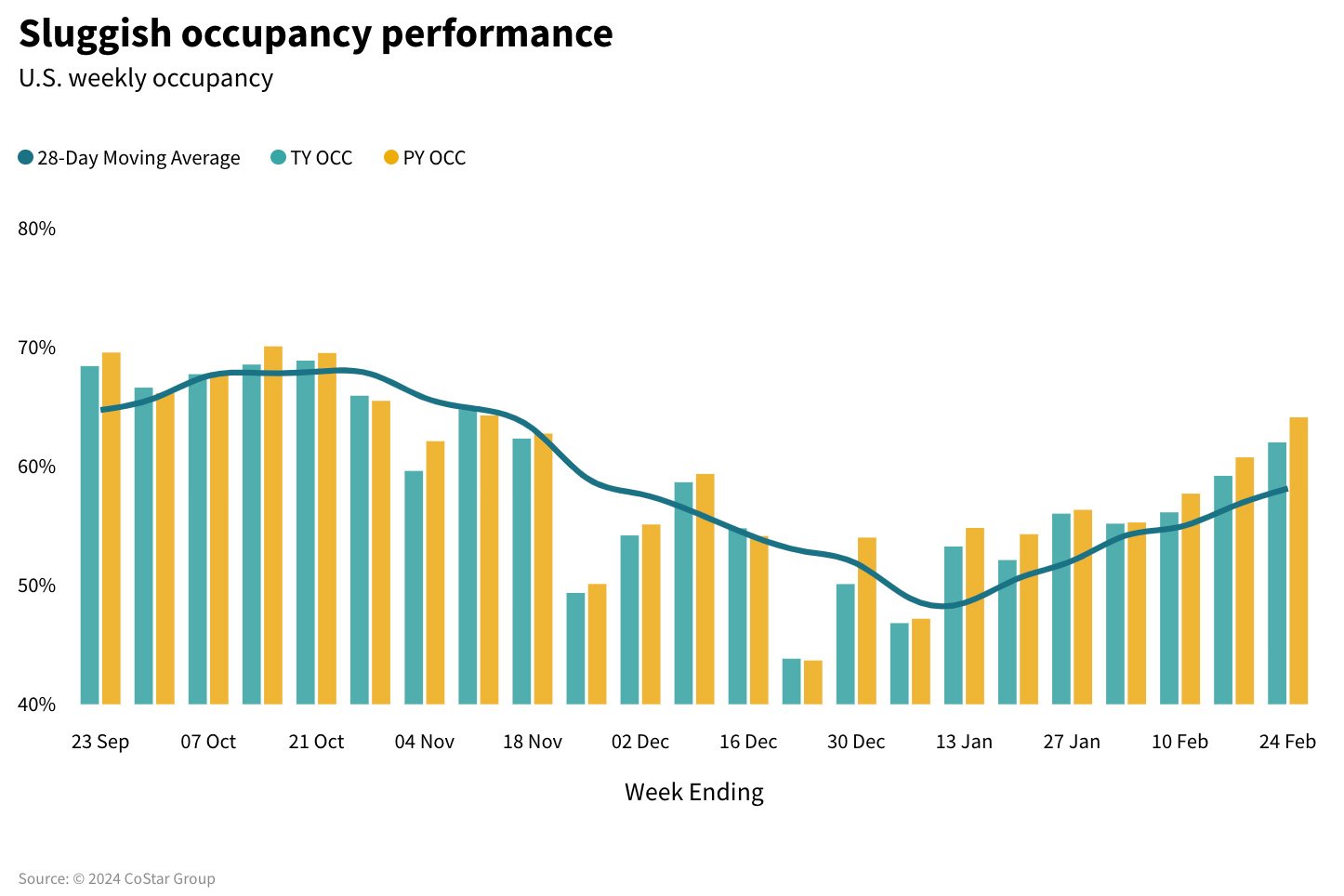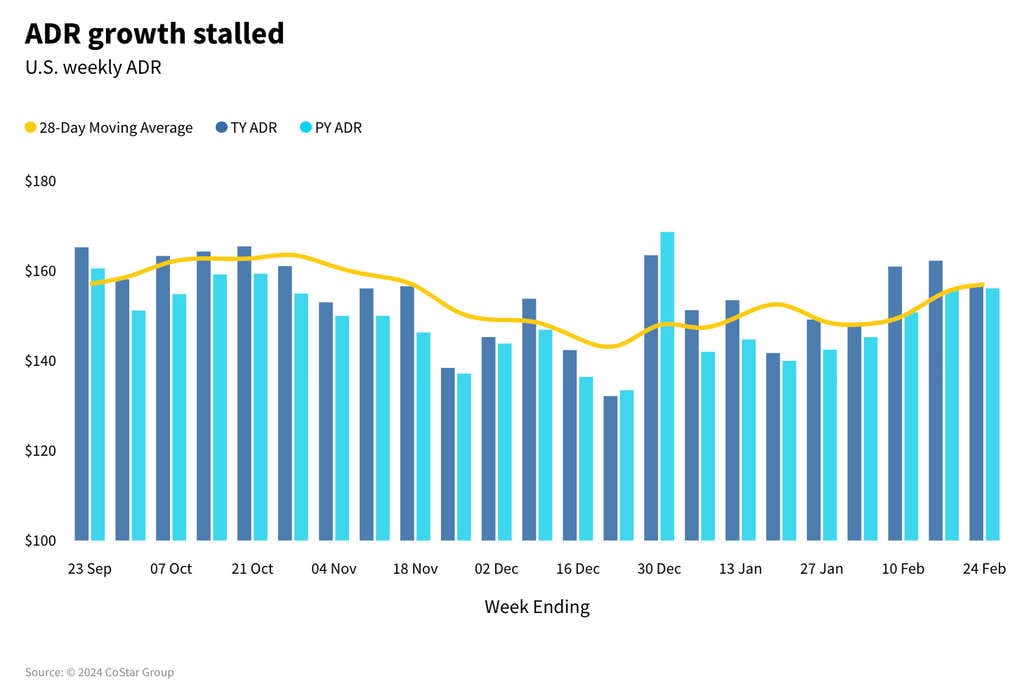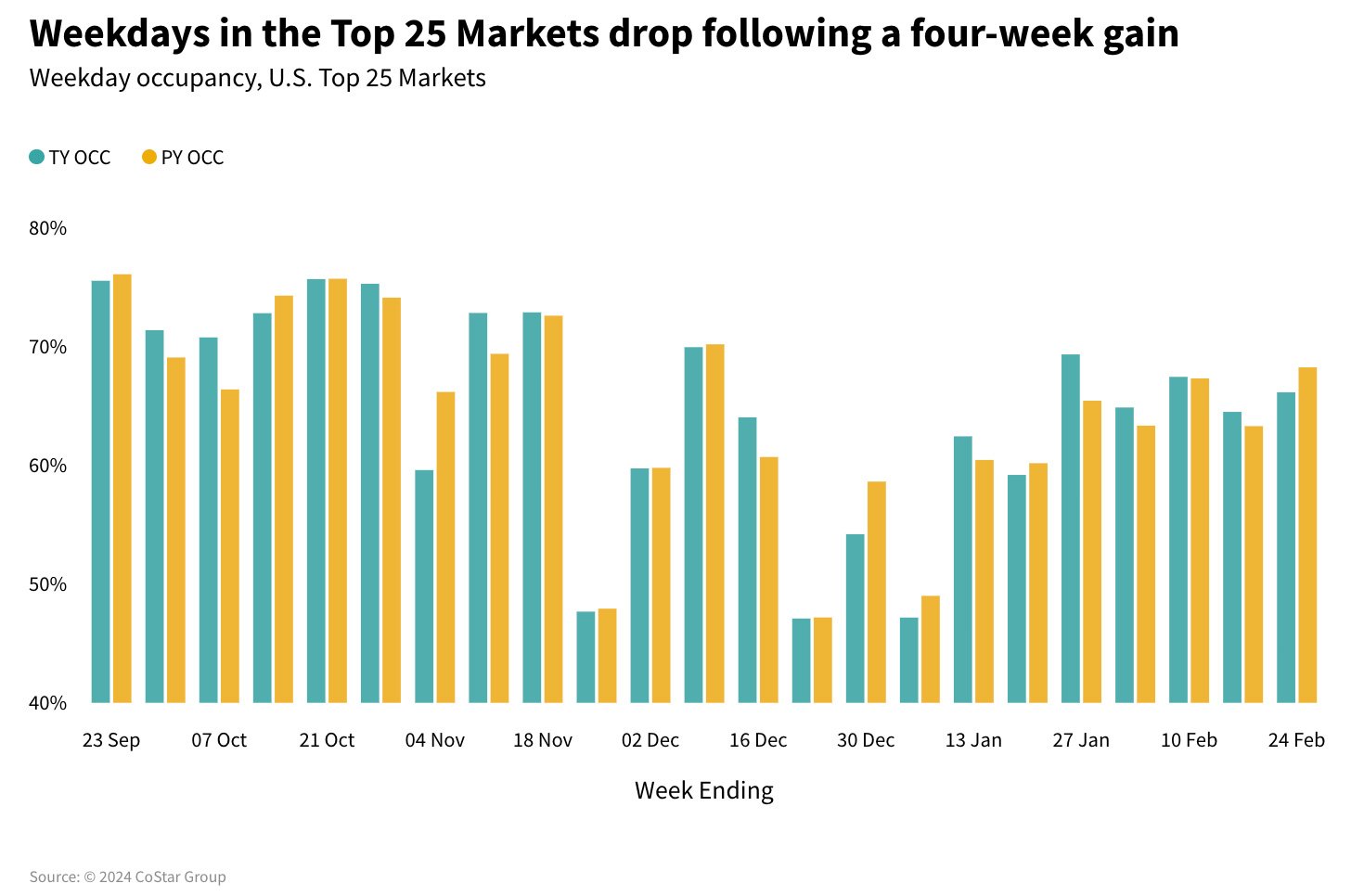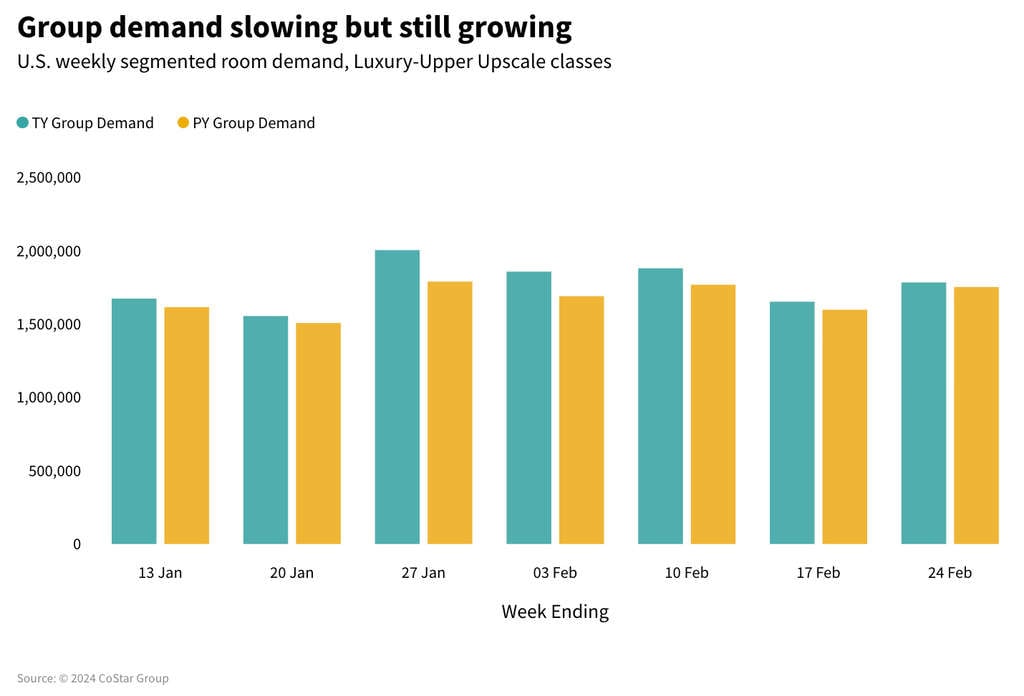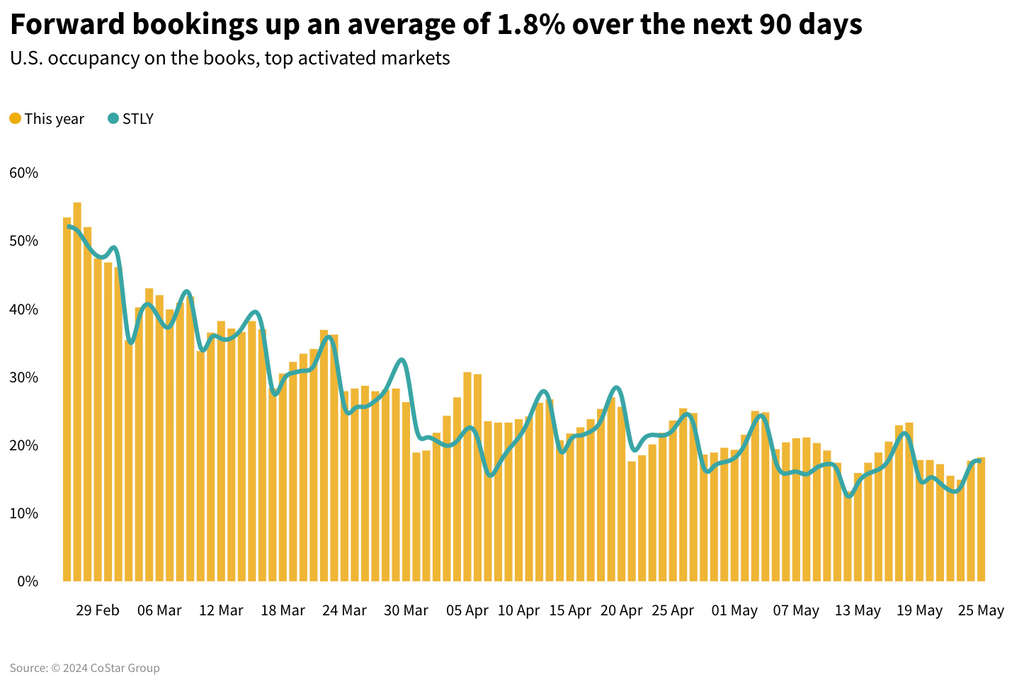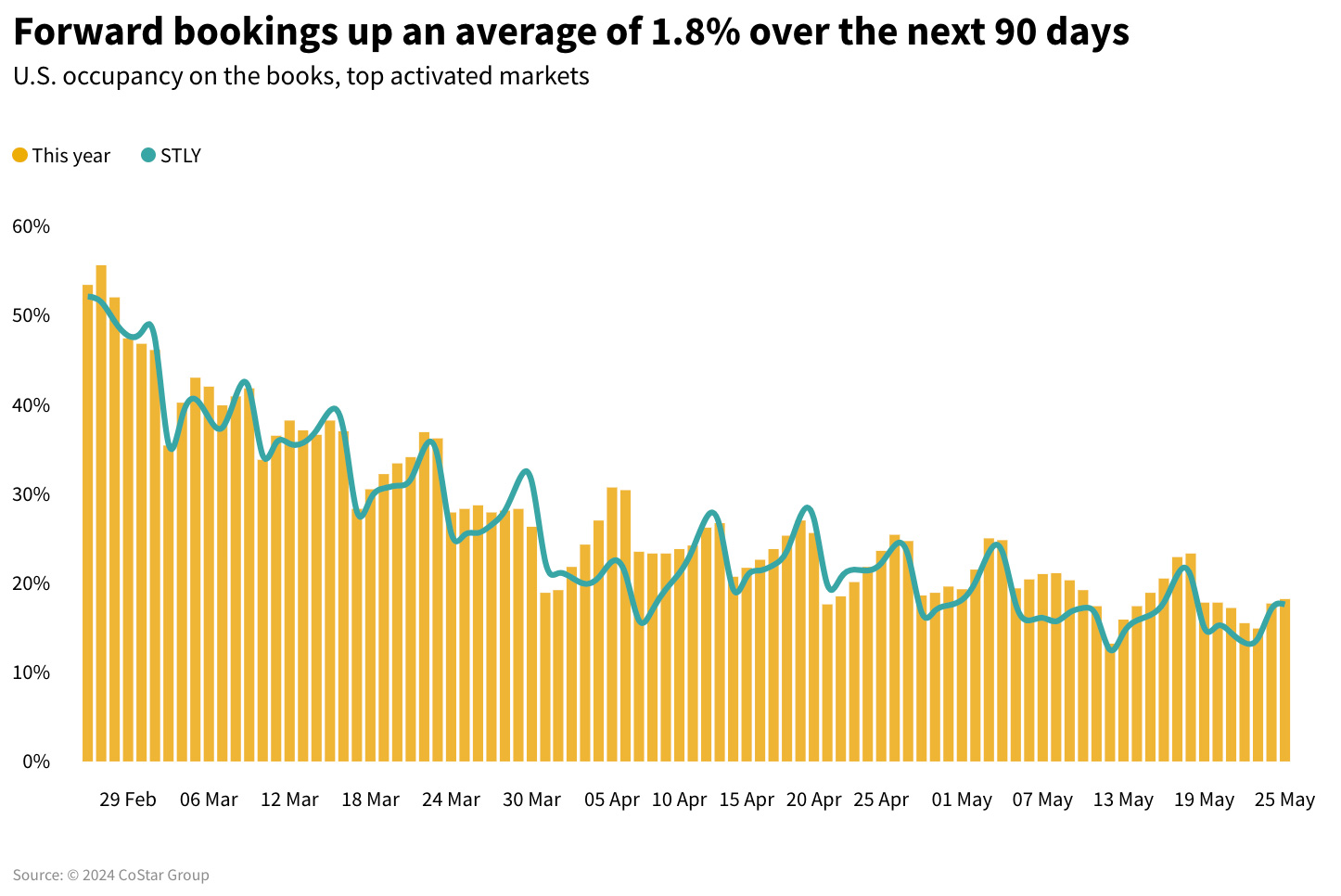STR Weekly Insights: 18-24 February 2024
Countries (markets) mentioned:
- United States (Cleveland, Las Vegas, Minneapolis, Washington, D.C.)
- Australia (Melbourne, Sydney), China, Germany
Highlights
- Slow week in the U.S., the Super Bowl was missed
- The weekend and groups were bright spots
- Soft week in China, too, post-Chinese New Year
- Taylor Swift bookends Australia
U.S. Performance
As a lead up to spring, U.S. hotels continued to see week-on-week occupancy growth, however, the rate of growth has slowed. The most recent level (62%) was the highest weekly occupancy of the year, up 2.8 percentage points (ppts) from the prior week, but down 2.1ppts year over year (YoY). While the week included Presidents’ Day, which tends to slow travel, the comparison was clean as the holiday occurred in the same week last year. More importantly, occupancy has declined YoY every week of the year so far with 51% of the gross lost demand coming from Economy class hotels. Upper Midscale class hotels have also seen decreases all year long and account for a quarter of the gross demand loss by the industry.
The week also saw average daily rate (ADR) stall, increasing a scant 0.3% YoY following two exceptional weeks due to the Super Bowl in Las Vegas. Recall, U.S. weekly ADR rose 4.2% and 6.8%, respectively, but excluding Las Vegas, the metric was flat. With both weak occupancy and ADR, revenue per available room (RevPAR) dropped 3.0% YoY, which was the second decrease this year and the largest thus far.
The Top 25 Markets were not immune to the week’s slowdown. Compared to the same week last year, occupancy decreased 2.1ppts and ADR was almost flat (+0.2%), which resulted in RevPAR decreasing 2.7%. The weekend (Friday & Saturday) was a bright spot for the Top 25 Markets as occupancy declined less (-1.3ppts) and ADR grew (+1.1%). As a result, weekend RevPAR was down 0.7% with weekdays (Monday – Wednesday) down 2.7% and shoulder days (Sunday and Thursday) down 5.0%. The rest of the country experienced a more severe yet similar slowdown with the smallest RevPAR declines on the weekends (-2.2%) and the largest decreases on shoulder days (-4.2%).
Individual Top 25 Market performance was also subdued. Only four markets (Oahu, Minneapolis, Las Vegas, and Washington D.C.) posted year-over-year RevPAR gains above 5%. Oahu led with a 10.1% RevPAR gain driven more by ADR (+7.5%) than occupancy (+2.1ppts). Minneapolis was boosted by a combination of ADR and RevPAR, while Las Vegas and Washington D.C.’s gain were all due to ADR. Across the next 25 largest markets, Cleveland posted the largest RevPAR gain (+14.0%) led by conventions and two Drake concerts over the weekend. New Orleans and Nashville saw sharp RevPAR declines due to a calendar shift in Mardi Gras for NOLA and a change in conventions for “Music City.”
Group demand continued to benefit with Luxury and Upper Upscale hotels increasing demand for a seventh consecutive week, up 1.8% compared to the same week last year. The increases seen over the past eight weeks are slowing. However, the growth pace over the next several weeks will provide good insight on the strength of group demand. This week’s group ADR was up 4.9% YoY and is not slowing—+5.1% on average over the past seven weeks. Like last week, 15 of the Top 25 Markets saw year-over-year group occupancy gains with Oahu and Las Vegas seeing double-digit ADR increases.
All hotel classes experienced softness during the week primarily due to occupancy declines. Luxury class hotels also saw ADR declines (-1.6%), while the middle three classes held ADR at about one percent. Midscale and Economy hotels continue to suffer the most with occupancy decreases (-2.7ppts and -3.5ppts, respectively) followed by ADR declines.
Global hotel performance
Hotel performance outside of the U.S. was generally positive except for China, which posted a year-on-year occupancy decline (-18.2ppts). It should be noted that the comparison was influenced by the shift in the Chinese New Year holiday. When matching up the appropriate seven days after the holiday, the occupancy difference is not as severe, although the metric did fall 4.6ppts versus the same period a year ago. The timing of the celebrations last year was also at the tail end of the COVID restrictions, which had the added increase of pent-up demand along with the added pressure of supply growth.
Removing China from a grouping of the largest supply countries, occupancy was up 1.1ppts to 67.6%, and ADR increased 1.6%, resulting in a RevPAR gain of 3.3%. Countries outside the top 10 increased occupancy 2.5ppts.
The continuation of Taylor Swift’s Tour in Australia bookended the week with Sunday’s performance in Melbourne and Friday/Saturday performances in Sydney lifting performance for the country by 3ppts in occupancy (77.7%) and 9.2% in ADR. Melbourne’s weekly occupancy increased 6.8ppts with ADR up 7.7%. In Sydney, the tour helped to raise ADR by 13.2% and occupancy 1.1ppts for the week.
Germany saw the largest increase in occupancy of the top 10 countries, rising 5.5ppts versus last year. Its performance is following expected seasonal trends via increased trade fairs. ADR continues to improve and was up 6.3%.
Looking ahead
As Spring travel gears up, falling demand and softening ADR in the U.S. is concerning, however, hotel performance is expected to grow in the weeks ahead. Positive forward bookings, the strength of group demand over the past seven weeks, and an early spring break season should provide tailwinds as the year progresses. Global performance continued to be strong and is expected to remain on a positive trajectory over the coming months, helped by Americans who continue to travel abroad. Australia has two more Taylor Swift concert nights and then she is onto Singapore for six nights.
Finally, Leap Day (Thursday, 29 February) will provide an added revenue day for the month and report as such in weekly data. However, monthly reporting will be “grossed down” into a 28-day month to allow for like-to-like comparisons versus previous years.
*Analysis by Isaac Collazo, Chris Klauda, Will Anns
About STR
STR provides premium data benchmarking, analytics and marketplace insights for the global hospitality industry. Founded in 1985, STR maintains a presence in 15 countries with a North American headquarters in Hendersonville, Tennessee, an international headquarters in London, and an Asia Pacific headquarters in Singapore. STR was acquired in October 2019 by CoStar Group, Inc. (NASDAQ: CSGP), the leading provider of commercial real estate information, analytics and online marketplaces. For more information, please visit str.com and costargroup.com.


